
1510
.pdf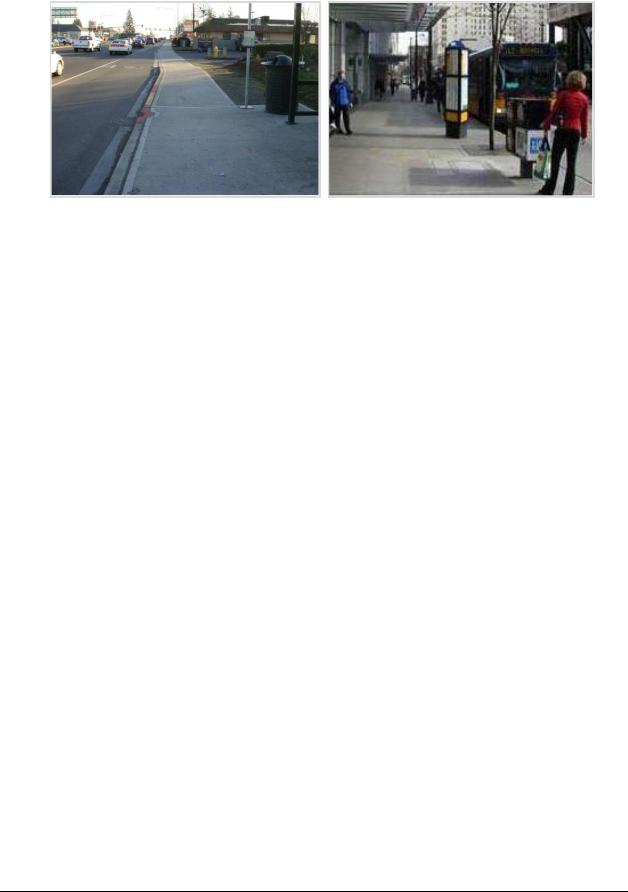
Chapter 1510 |
Pedestrian Facilities |
|
|
Pedestrian Circulation Paths
Exhibit 1510-1
Highway shoulders are an extension of the roadway and are not typically considered pedestrian facilities. Pedestrians are allowed to use many state highways. Although pedestrians are allowed to travel along the shoulder in these cases, its main purpose is to provide an area for disabled vehicles, a recovery area for errant vehicles, and positive drainage away from the roadway.
Shoulders may serve as a pedestrian facility when sidewalks are not provided. If pedestrian generators, such as bus stops, are present and pedestrian usage is evident, a 4- foot-wide paved shoulder is adequate.
Where pedestrian traffic is evident, consider a separate pedestrian circulation path during the planning and programming of the project. Consult with the State Bicycle and Pedestrian Coordinator.
(1)Accessibility Criteria for Pedestrian Circulation Paths
The following criteria apply across the entire width of the pedestrian circulation path, not just within the pedestrian access route.
(a)Vertical Clearance
The minimum vertical clearance for objects that protrude into or overhang a pedestrian circulation path is 80 inches.
If the minimum vertical clearance cannot be provided, railings or other barriers shall be provided. The leading bottom edge of the railing or barrier shall be located 27 inches maximum above the finished surface for cane detection.
Note: Per the MUTCD, the vertical clearance to the bottom of signs is 7 feet (84 inches.)
(b)Horizontal Encroachment
Protruding objects on pedestrian circulation paths shall not reduce the clear width of the pedestrian access route to less than 4 feet, exclusive of the curb.
Note: If an object must protrude farther than 4 inches into a pedestrian circulation path at a height that is greater than 27 inches and less than 80 inches above the finished surface, then it must be equipped with a warning device that is
WSDOT Design Manual M 22.01.08 |
Page 1510-11 |
July 2011 |
|

Pedestrian Facilities |
Chapter 1510 |
detectable by a vision-impaired person who navigates with a cane. The minimum clear width of the pedestrian access route must still be provided.
(c)Post-Mounted Objects
Objects mounted on posts, at a height that is greater than 27 inches and less than 80 inches above the finished surface, shall not protrude more than 4 inches into a pedestrian circulation path.
Note: If an object must protrude farther than 4 inches into a pedestrian circulation path at a height that is greater than 27 inches and less than 80 inches above the finished surface, then it must be equipped with a warning device that is detectable by a vision-impaired person who navigates with a cane. The minimum clear width of the pedestrian access route must still be provided.
Where a sign or other obstruction on a pedestrian circulation path is mounted on multiple posts, and the clear distance between the posts is greater than 12 inches, the lowest edge of the sign or obstruction shall be either 27 inches maximum or 80 inches minimum above the finished surface.
1510.07 Pedestrian Access Routes (PARs)
All pedestrian circulation paths (PCPs) are required to contain a continuous pedestrian access route (see Exhibit 1510-2) that connects to all adjacent pedestrian facilities, elements, and spaces that are required to be accessible. Pedestrian access routes consist of one or more of the following pedestrian facilities: walkways/sidewalks, crosswalks, curb ramps (excluding flares), landings, pedestrian overpasses/underpasses, access ramps, elevators, and platform lifts.
Page 1510-12 |
WSDOT Design Manual M 22-01.08 |
|
July 2011 |
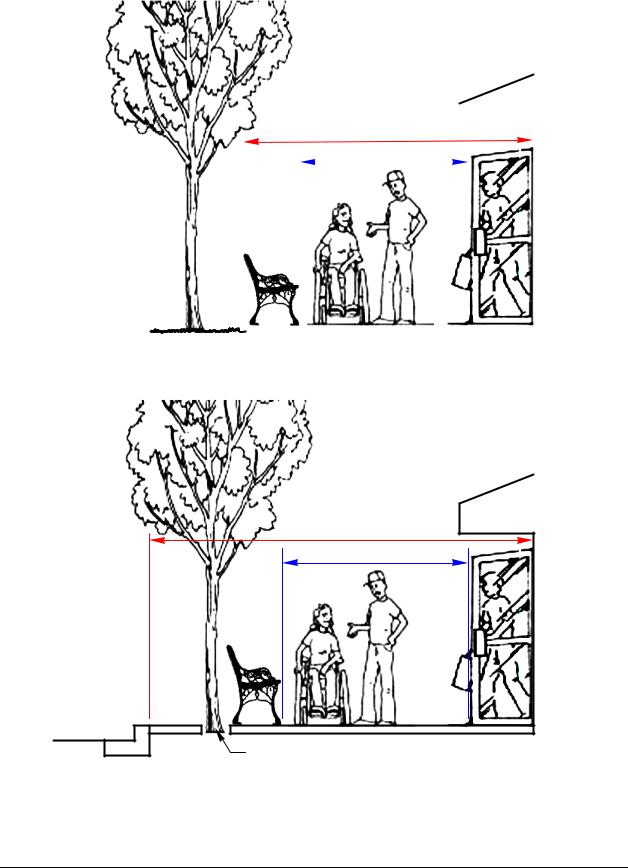
Chapter 1510 |
|
Pedestrian Facilities |
||||||||
|
|
|
|
|
|
|
|
|
|
|
|
|
|
|
|
|
|
|
|
|
|
|
|
|
|
|
|
|
|
|
|
|
|
|
|
|
|
|
|
|
|
|
|
|
|
|
|
|
|
|
|
|
|
|
|
|
|
|
|
|
|
|
|
|
|
|
|
|
|
|
|
|
|
|
|
|
|
|
|
|
|
|
|
|
|
|
|
|
|
|
|
|
|
|
|
|
|
|
|
|
|
|
|
|
|
|
|
|
|
With Continuous Buffer
Without Continuous Buffer
Relationship Between Pedestrian Circulation Paths and Pedestrian Access Routes
Exhibit 1510-2
WSDOT Design Manual M 22.01.08 |
Page 1510-13 |
July 2011 |
|
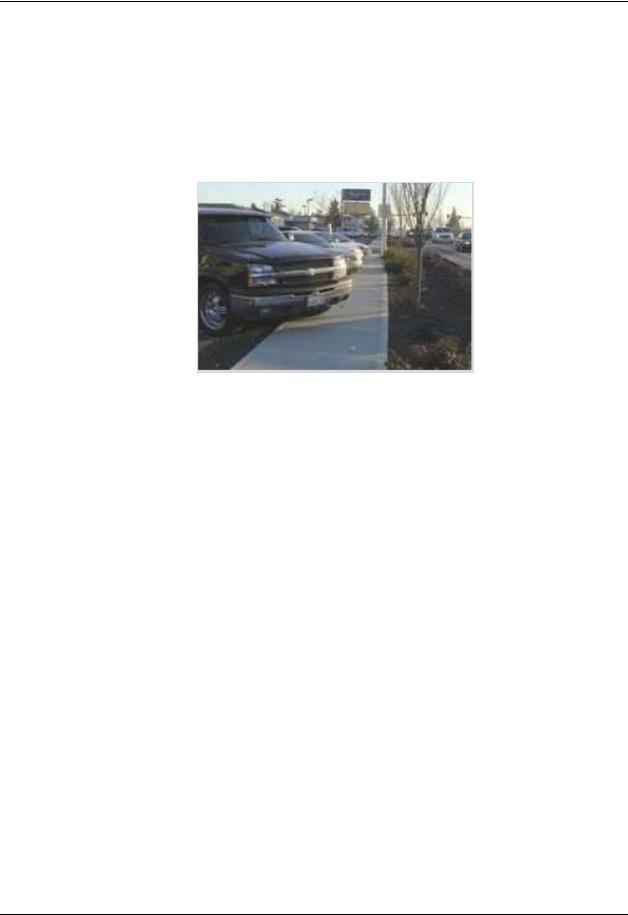
Pedestrian Facilities |
Chapter 1510 |
(1)Accessibility Criteria for Pedestrian Access Routes
(a)Clear Width
The minimum continuous and unobstructed clear width of a pedestrian access route shall be 4 feet, exclusive of the width of the curb.
Pedestrian access routes that are less than 5 feet in clear width, exclusive of the width of the curb, shall provide passing spaces at intervals no further apart than 200 feet. Passing spaces shall be 5 feet wide minimum for a minimum distance of 5 feet.
This Exhibit depicts a condition where the PAR has been reduced to less than the minimum clear width, resulting in an unacceptable condition.
Obstructed Pedestrian Access Route
Exhibit 1510-3
(b)Grade and Cross Slope
The cross slope of a pedestrian access route shall be 2% maximum.
Note: It is recommended that cross slopes be designed to be less than the allowed maximum to allow for some tolerance in construction. For example: design for
a maximum 1.5% cross slope (rather than 2% maximum). Exceptions:
1.Midblock crosswalks – The cross slope of the crosswalk and any connected curb ramp are permitted to match street or highway grade.
2.Crosswalks without stop sign control – The cross slope of the crosswalk can be up to 5% maximum.
Where a pedestrian access route is contained within the highway right of way, its grade shall not exceed the general grade established for the adjacent roadway.
Exception: The maximum grade in a crosswalk (marked or unmarked) is 5%, measured parallel to the direction of pedestrian travel in the crosswalk.
Where a pedestrian access route is not contained within the highway right of way, the maximum running slope allowed is 5% unless designed as an access ramp. (See 1510.15(2) for access ramp accessibility criteria.)
For additional criteria when a pedestrian access route is supported by a structure, see 1510.14.
Page 1510-14 |
WSDOT Design Manual M 22-01.08 |
|
July 2011 |

Chapter 1510 |
Pedestrian Facilities |
|
|
(c)Surface
The surface of the pedestrian access route shall be firm, stable, and slip resistant. Use hard surfaces like cement or asphalt concrete surfaces; crushed gravel is not considered to be a stable, firm surface.
Vertical alignment shall be planar within curb ramps, landings, and gutter areas within the pedestrian access route and within clear spaces for accessible pedestrian signals, street furniture, and operable parts.
Grade breaks shall be flush.
Surface discontinuities (see Exhibit 1510-4) on existing surfaces in the pedestrian access route (such as at the joints of settled or upheaved sidewalk panels) may not exceed ½ inch maximum. Vertical discontinuities between ¼ inch and ½ inch maximum shall be beveled at 2H:1V minimum. Apply the bevel across the entire level change.
Exception: No surface discontinuity is allowed at the connection between an existing curb ramp or landing and the gutter. This grade break must be flush.
Surface Discontinuities (Noncompliant)
Exhibit 1510-4
Gratings, access covers, utility objects, and other appurtenances shall not be located on curb ramps, landings, or gutters within the pedestrian access route.
Locate gratings, access covers, utility objects, and other appurtenances outside the pedestrian access route on walkways and sidewalks. Where this is not possible, ensure covers, grates, and lids are designed to be slip resistant and are installed flush with the surrounding surface (see the Standard Plans).
(d)Horizontal Openings
Any sidewalk joints or gratings that are in the pedestrian access route shall not permit passage of a sphere more than ½ inch in diameter.
Elongated openings shall be placed so that the long dimension is perpendicular to the dominant direction of travel.
WSDOT Design Manual M 22.01.08 |
Page 1510-15 |
July 2011 |
|
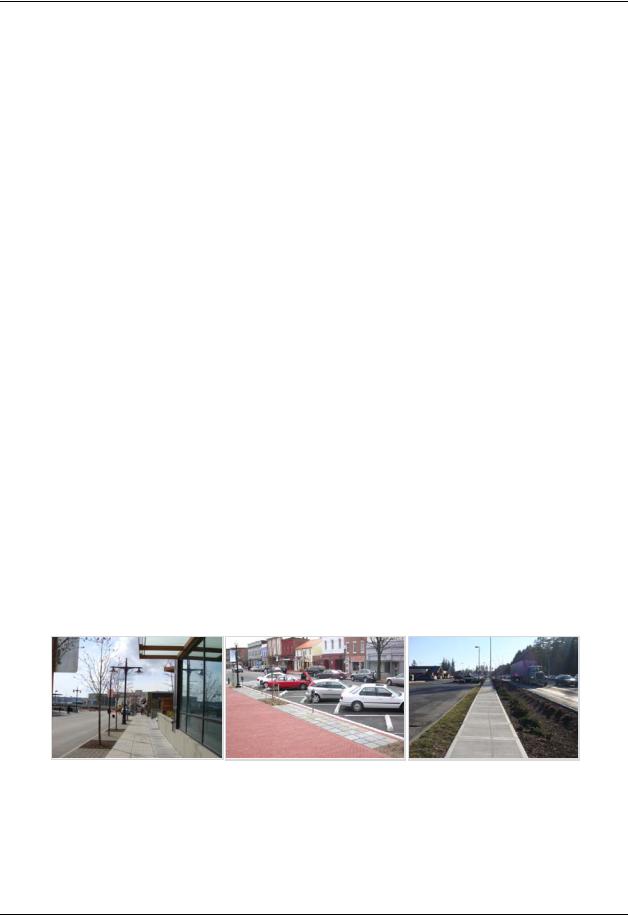
Pedestrian Facilities |
Chapter 1510 |
Openings for wheel flanges at pedestrian crossings of nonfreight rail track shall be 2½ inches maximum (3 inches maximum for freight rail track).
For additional requirements when a pedestrian access route crosses a railroad, see 1510.13.
1510.08 Sidewalks
Sidewalks are one type of pedestrian circulation path. (See 1510.06 for pedestrian circulation path accessibility criteria.) Plan the design of sidewalks carefully to include a pedestrian access route that provides universal access. (See 1510.07 for pedestrian access route accessibility criteria.) Sidewalk design elements are found in Exhibit 1510-6 and details for raised sidewalks are shown in the Standard Plans. Wherever appropriate, make sidewalks continuous and provide access to side streets. The most pleasing and comfortable installation for the pedestrian is a sidewalk separated from the traveled way by a planted buffer. This provides a greater separation between vehicles and pedestrians than curb alone.
(1)Sidewalk and Buffer Widths
Where a sidewalk is separated from the roadway by only a curb, the WSDOT minimum sidewalk width is 6 feet (excluding the curb). Note: When evaluating existing sidewalk that is at least 5 feet wide (excluding the curb) and meets all other accessibility criteria, it should be documented as a Design Exception that does not require reconstruction.
Where a sidewalk is separated from the roadway by a buffer (see Exhibit 1510-5) that is at least 3 feet wide (excluding the curb), the WSDOT minimum sidewalk width is 5 feet.
If trees or shrubs are included in a buffer, coordinate with the region or HQ Landscape Architect and refer to the Roadside Manual. Take into account Design Clear Zone guidelines (see Chapter 1600). Design subsurface infrastructure (such as structural soils) and select plants whose root systems do not cause sidewalks to buckle or heave. Coordinate buffer planting with maintenance personnel.
Where possible, strive to accommodate snow storage while keeping the pedestrian route free of snow accumulation. Make sure maintenance access is not obstructed. Shoulders, bike lanes, and on-street parking are not considered buffers, but they do offer the advantage of further separation between vehicles and pedestrians.
Sidewalks With Buffers
Exhibit 1510-5
Page 1510-16 |
WSDOT Design Manual M 22-01.08 |
|
July 2011 |
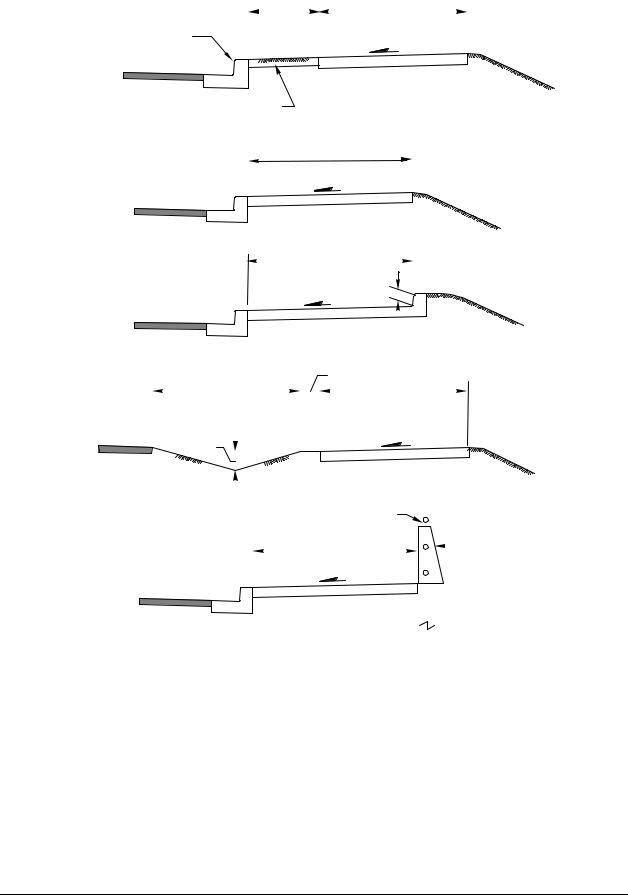
Chapter 1510 |
|
|
|
|
|
|
|
|
|
|
|
|
|
|
|
|
|
|
|
|
|
Pedestrian Facilities |
|||||
|
|
|
|
|
|
|
|
|
|
|
|
|
|
|
|
|
|
|
|
|
|
|
|
|
|
|
|
|
|
|
|
|
|
|
|
|
|
|
|
|
|
|
|
|
|
|
|
|
|
|
|
|
|
|
|
|
|
|
|
|
|
|
|
|
|
|
|
|
|
|
|
|
|
|
|
|
|
|
|
|
|
|
|
|
|
|
|
|
|
|
|
|
|
|
|
|
|
|
|
|
|
|
|
|
|
|
|
|
|
|
|
|
|
|
|
|
|
|
|
|
|
|
|
|
|
|
|
|
|
|
|
|
|
|
|
|
|
|
|
|
|
|
|
|
|
|
|
|
|
|
|
|
|
|
|
|
|
|
|
|
|
|
|
|
|
|
|
|
|
|
|
|
|
|
|
|
|
|
|
|
|
|
|
|
|
|
|
|
|
|
|
|
|
|
|
|
|
|
|
|
|
|
|
|
|
|
|
|
|
|
|
|
|
|
|
|
|
|
|
|
|
|
|
|
|
|
|
|
|
|
|
|
|
|
|
|
|
|
|
|
|
|
|
|
|
|
|
|
|
|
|
|
|
|
|
|
|
|
|
|
|
|
|
|
|
|
|
|
|
|
|
|
|
|
|
|
|
|
|
|
|
|
|
|
|
|
|
|
|
|
|
|
|
|
|
|
|
|
|
|
|
|
|
|
|
|
|
|
|
|
|
|
|
|
|
|
|
|
|
|
|
|
|
|
|
|
|
|
|
|
|
|
|
|
|
|
|
|
|
|
|
|
|
|
|
|
|
|
|
|
|
|
|
|
|
|
|
|
|
|
|
|
|
|
|
|
|
|
|
|
|
|
|
|
|
|
|
|
|
|
|
|
|
|
|
|
|
|
|
|
|
|
|
|
|
|
|
|
|
|
|
|
|
|
|
|
|
|
|
|
|
|
|
|
|
|
|
|
|
|
|
|
|
|
|
|
|
|
|
|
|
|
|
|
|
|
|
|
|
|
|
|
|
|
|
|
|
|
|
|
|
|
|
|
|
|
|
|
|
|
|
|
|
|
|
|
|
|
|
|
|
|
|
|
|
|
|
|
|
|
|
|
|
|
|
|
|
|
|
|
|
|
|
|
|
|
|
|
|
|
|
|
|
|
|
|
|
|
|
|
|
|
|
|
|
|
|
|
|
|
|
|
|
|
|
|
|
|
|
|
|
|
|
|
|
|
|
|
|
|
|
|
|
|
|
|
|
|
|
|
|
|
|
|
|
|
|
|
|
|
|
|
|
|
|
|
|
|
|
|
|
|
|
|
|
|
|
|
|
|
|
|
|
|
|
|
|
|
|
|
|
|
|
|
|
|
|
|
|
|
|
|
|
|
|
|
|
|
|
|
|
|
|
|
|
|
|
|
|
|
|
|
|
|
|
|
|
|
|
|
|
|
|
|
|
|
|
|
|
|
|
|
|
|
|
|
|
|
|
|
|
|
|
|
|
|
|
|
|
|
|
|
|
|
|
|
|
|
|
|
|
|
|
|
|
|
|
|
|
|
|
|
|
|
|
|
|
|
|
|
|
|
|
|
|
|
|
|
|
Notes:
If vertical drop is within the Design Clear Zone and the posted speed is > 35 mph, then barrier may be needed (see Chapter 1600).
If vertical drop is >2 feet 6 inches and barrier is not needed, then railing is indicated.
If vertical drop is < 2 feet 6 inches and barrier is not needed, then a 4-inch curb at back of sidewalk is adequate.
General:
See the Standard Plans for details on slopes at back of sidewalk. See Chapter 1230 for slope selection criteria.
Sidewalks may be sloped away from the roadway for stormwater treatment (see the Highway Runoff Manual).
Typical Sidewalk Designs
Exhibit 1510-6
WSDOT Design Manual M 22.01.08 |
Page 1510-17 |
July 2011 |
|
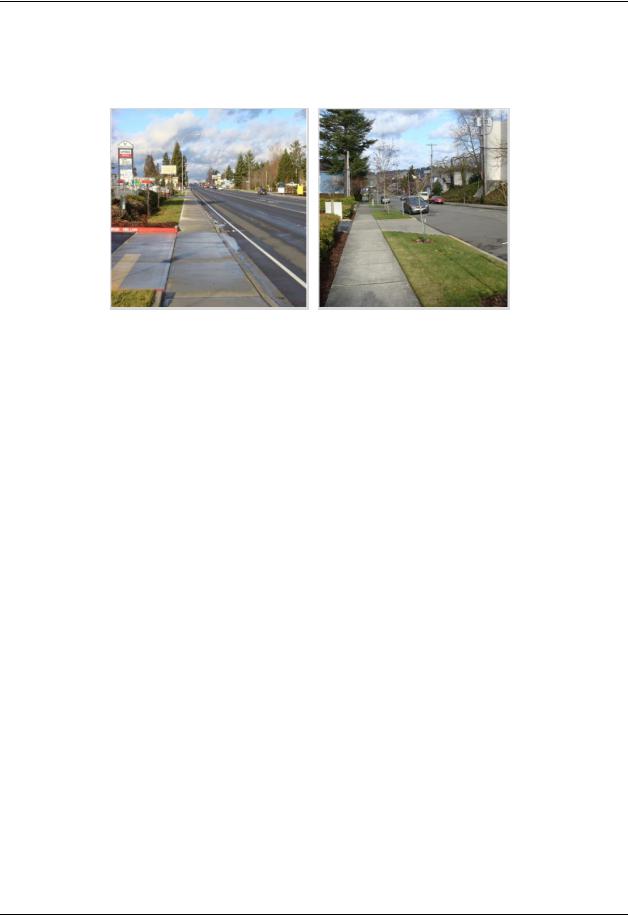
Pedestrian Facilities |
Chapter 1510 |
(2) Sidewalks at Driveways
Provide a pedestrian access route where driveways intersect a pedestrian circulation path (see Exhibit 1510-7). The Standard Plans shows details of driveway designs that provide a pedestrian access route. (See 1510.06 and 1510.07 for accessibility criteria.)
Typical Driveways
Exhibit 1510-7
1510.09 Curb Ramps
Curb ramps provide an accessible connection from a raised sidewalk down to the roadway surface. A curb ramp, or combination of curb ramps, is required to connect pedestrian access routes to crosswalks (marked or unmarked) where curbs and sidewalks are present, except where pedestrian crossing is prohibited. (See 1510.10(2)(c) for guidance on closed crossings and Exhibit 1510-16 for examples.)
For new construction projects, provide a curb ramp oriented in each direction of pedestrian travel within the width of the crosswalk it serves. For alteration projects, a curb ramp oriented in each direction of pedestrian travel within the width of the crosswalk it serves is desirable.
Every curb ramp must have a curb ramp at the other end of the crosswalk it serves unless there is no curb or sidewalk on that side (RCW 35.68.075).
Curb ramps are also required at midblock crossings where curbs and sidewalks are present.
(1)Types of Curb Ramps
Different types of curb ramps can be used: perpendicular, parallel, and combination. Carefully analyze and take into consideration drainage patterns, especially when designing a parallel or combination curb ramp installation.
(a)Perpendicular Curb Ramp
Perpendicular curb ramps (see Exhibits 1510-8 and 1510-9) are aligned to cut through the curb and meet the gutter grade break at a right angle. The landing is to be located at the top of the curb ramp.
Page 1510-18 |
WSDOT Design Manual M 22-01.08 |
|
July 2011 |

Chapter 1510 |
Pedestrian Facilities |
|
|
1.Advantages
•Having the path of travel aligned to cross the gutter grade break at a right angle facilitates usage by individuals with mobility devices.
•The height of the ramp run relative to the gutter elevation may facilitate drainage.
•The height of the ramp run relative to the gutter elevation discourages vehicular traffic from cutting across the corner.
•On small-radius corners, the ramp alignment may be more closely aligned with the alignment of the crosswalk markings, which facilitates direction finding for the visually impaired.
2.Disadvantages
•The ramp run and landing might not fit within available right of way.
•On small-radius corners, the flares may not fit between closely spaced perpendicular curb ramps.
•On larger-radius corner there will be less facilitation of direction finding for the visually impaired due to the requirement that the path of travel cross the gutter grade break at a right angle.
Perpendicular Curb Ramp
Exhibit 1510-8
WSDOT Design Manual M 22.01.08 |
Page 1510-19 |
July 2011 |
|
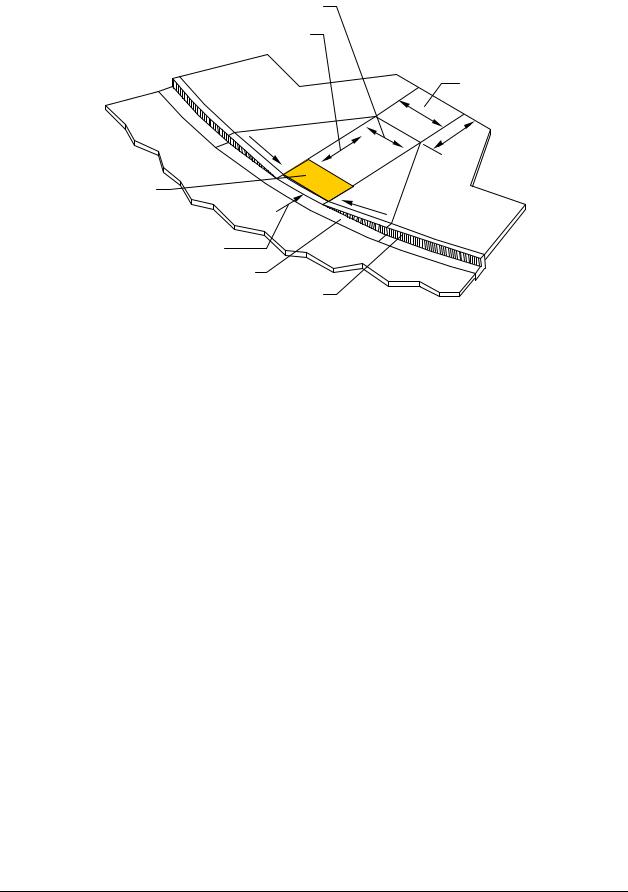
Pedestrian Facilities |
Chapter 1510 |
|
|
Perpendicular Curb Ramp Common Elements
Exhibit 1510-9
(b)Parallel Curb Ramp
Parallel curb ramps (see Exhibits 1510-10 and 1510-11) are aligned with their running slope in line with the direction of sidewalk travel, parallel to the curb. The landing is located at the bottom of the curb ramp.
1.Advantages
•Requires minimal right of way.
•Allows ramps to be extended to reduce ramp grade within available right of way.
•Provides edges on the side of the ramp that are detectable to vision-impaired pedestrians who navigate with a cane.
2.Disadvantages
•Depending on the style of parallel curb ramp, pedestrian through traffic on the sidewalk may need to negotiate two ramp grades instead of one, possibly making it more difficult to traverse for some.
•The installation of additional drainage features in the upstream gutter line may be necessary to prevent the accumulation of water or debris in the landing at the bottom of the ramp.
Page 1510-20 |
WSDOT Design Manual M 22-01.08 |
|
July 2011 |
